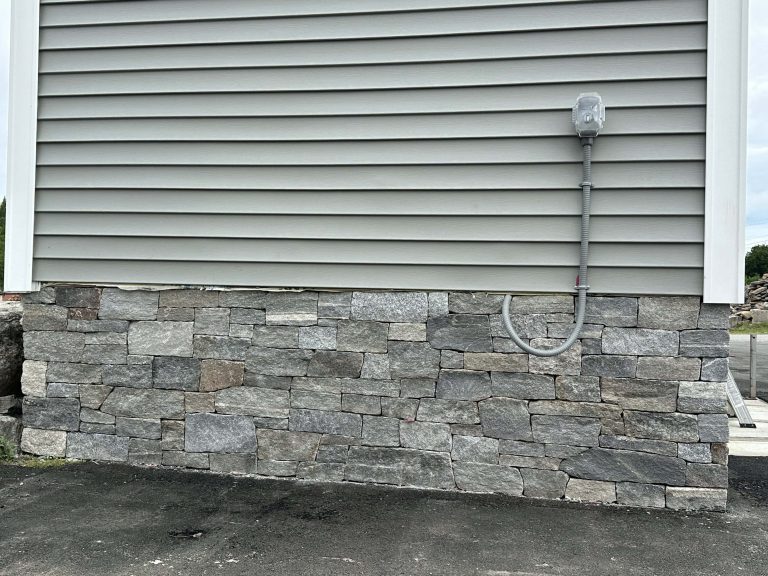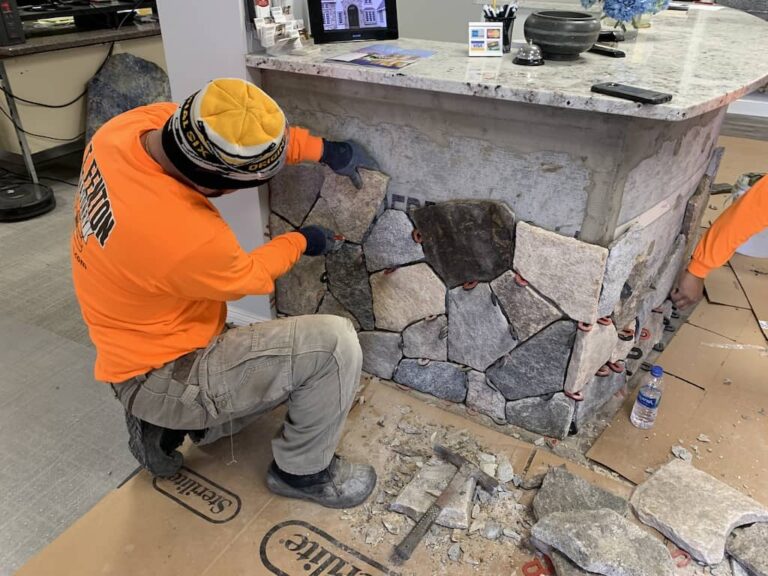A Builder’s Guide to Exterior Cladding Stone
When considering a stone home, traditional masonry—thick, heavy blocks of stone requiring a massive foundation—often comes to mind. Natural thin stone veneer offers the same timeless, rugged appearance without the immense structural weight and cost. That’s where exterior cladding stone from Stoneyard comes in.
This guide focuses exclusively on New England–sourced natural thin stone veneer, a modern solution that delivers the authentic beauty of real stone. This is 100% real fieldstone or quarried stone, crafted in New England and sawn to approximately 1 inch thick. It has the genuine texture, rich color, and freeze–thaw durability that only real natural stone provides.
What Are Natural Stone Cladding Systems?
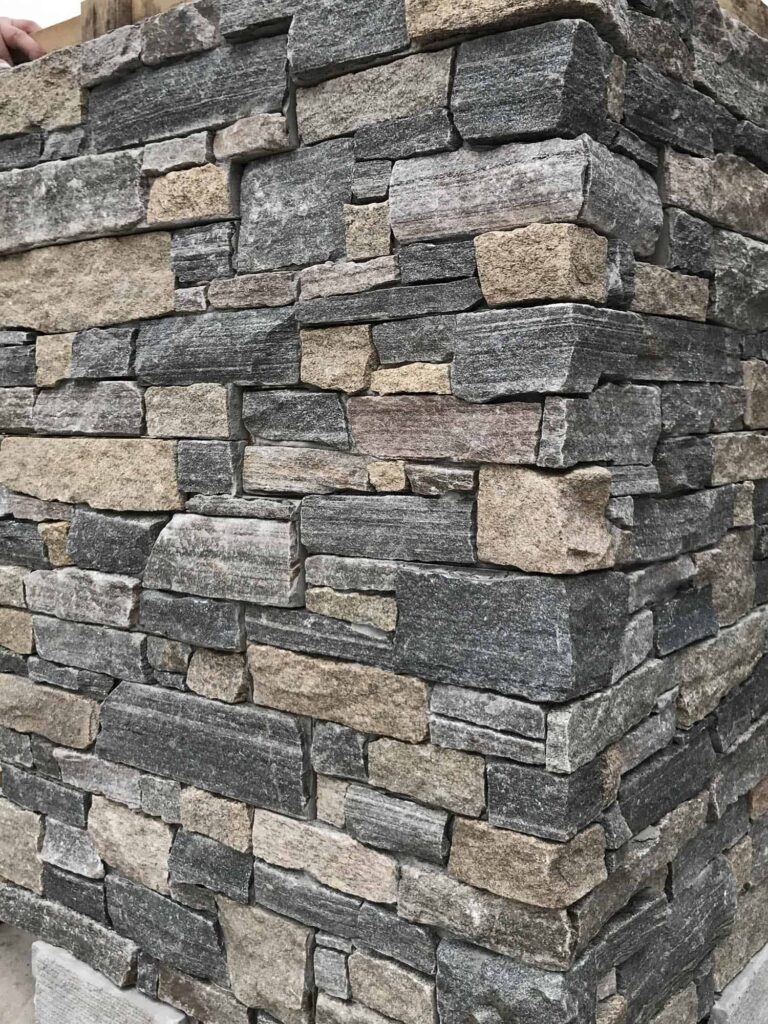
Exterior cladding stone is a system where real natural stone is applied to a building’s exterior, providing a durable, high-performance finish. Stoneyard’s thin stone veneer is a significant advancement over old-school masonry.
We start with genuine fieldstone or quarried stone from New England. At our Littleton, MA facility, we use specialized saws to slice it to an approximate thickness of one inch (ranging from ¾” to 1¼”). This process dramatically reduces the weight while keeping the original, weathered face of the stone intact. The result is a real stone siding product light enough for installation over masonry, concrete, or framed walls with lath and a scratch coat.
The Best of Both Worlds
Exterior cladding stone bridges the gap between the permanence of geologic material and the practical demands of modern construction. For builders, architects, and homeowners, this approach unlocks key advantages.
- 100% Real Stone: This is not a manmade concrete product. Every piece is natural stone, meaning the color and texture are integral to the material. It will never flake, peel, or fade.
- Lightweight Strength: At just 13-15 lbs per square foot, our New England thin stone veneer is a fraction of the weight of full-bed stone. This eliminates the need for expensive, reinforced foundational ledges.
- Full-Depth Appearance: When installed with our matching corner pieces, the finished look is indistinguishable from traditional, full-depth stone masonry. You get the full-depth appearance at one-third the weight.
- Built for Tough Weather: Sourced from New England, our stone is naturally dense with low water absorption, making it Harsh Climate Approved (HCA) and incredibly resistant to freeze–thaw damage.
Stoneyard’s system was designed to bring the heritage and permanence of New England stone into today’s building world. It offers an authentic, multi-decade performance that manufactured products from competitors like Eldorado Stone or Cultured Stone simply can’t match.
By choosing a natural stone cladding system, you’re specifying a material that has already proven its durability over millions of years. It’s an investment in a low-maintenance exterior that adds authentic character and long-term value to any property.
To get a closer look at how it all comes together, you can explore the fundamentals of natural stone cladding.
Natural Thin Stone vs Full Bed Stone At a Glance
For professionals who need the hard numbers, this table breaks down exactly how our thin veneer stacks up against traditional full bed stone. It highlights the key differences that impact everything from structural engineering to project budgets.
| Specification | Stoneyard Natural Thin Stone Veneer | Traditional Full Bed Stone |
|---|---|---|
| Thickness | ¾” – 1¼” (Approx. 1″) | 3” – 5” |
| Weight | ~13-15 lbs / sq. ft. | ~45-60 lbs / sq. ft. |
| Foundation Required | No (adheres to substrate) | Yes (structural footing/ledge) |
| Installation | Adhered with mortar over lath | Set in mortar bed on footing |
| Material Cost | Lower per square foot | Higher per square foot |
| Shipping Cost | Significantly lower due to weight | Significantly higher due to weight |
| Labor Cost | Generally lower and faster | Generally higher and slower |
| Application | New construction & remodels | Primarily new construction |
As you can see, the specifications for natural thin stone veneer make it a far more versatile and cost-effective solution for achieving an authentic stone finish on a wide range of projects.
The Performance Advantage of Real New England Stone
When choosing an exterior cladding, long-term performance is critical. Real New England stone from Stoneyard delivers proven durability rooted in its natural geological makeup. Sourced directly from our region’s quarries and fields and crafted at our Littleton, MA facility, this stone has already withstood thousands of years of harsh weather.
Unlike manufactured concrete alternatives, the performance of natural stone is inherent. It is not the result of chemical additives or surface-level pigments. Its dense structure and low water absorption provide exceptional, built-in resistance to weathering and freeze–thaw cycles.
Engineered by Nature for Harsh Climates
Every one of our thin stone veneer products is Harsh Climate Approved (HCA). This is our guarantee that the stone can endure severe freeze-thaw cycles without spalling, cracking, or delaminating. For anyone building in regions with harsh winters, this is a non-negotiable performance feature.
When porous materials absorb water and then freeze, the expanding ice causes damage. This is a common failure point for manufactured concrete veneers. Real New England stone’s dense composition minimizes water absorption, stopping that destructive cycle before it starts.
Natural New England stone veneer delivers multi-decade performance with minimal maintenance and no color fading. This ensures that the building’s aesthetic integrity remains intact for generations, protecting the owner’s investment.
This natural resilience translates directly to a low-maintenance exterior. The stone requires no sealing or painting and won’t degrade from UV exposure, salt spray, or acid rain. For a deeper dive into its suitability, explore our guide on why natural thin veneer stone is best for exterior use.
Authenticity and Long-Term Value
The color of our natural stone is solid all the way through. This is a crucial difference compared to manufactured products like Eldorado Stone or Cultured Stone, which rely on surface pigments that can fade or flake away over time. Real stone simply ages gracefully, developing a natural patina that adds to its character over the decades.
The market for authentic, sustainable building materials is growing, reflecting a clear demand for products that offer both lasting performance and regional character. Local sourcing from New England also supports a low transportation impact.
Beyond aesthetics, real stone offers tangible benefits. The inherent thermal mass of real exterior cladding stone can contribute to a home’s thermal performance, aligning with effective passive solar home design principles. Its ability to absorb and slowly release heat helps regulate interior temperatures.
Ultimately, choosing authentic New England stone is an investment in permanence. It provides a superior return through minimal maintenance, enduring beauty, and an undeniable increase in a property’s long-term resale value.
Real Stone Veneer vs. Manufactured Stone
One of the most critical decisions is between real natural stone and manufactured imitations. Stoneyard provides 100% real natural stone veneer, crafted at our Littleton, MA facility from authentic New England fieldstone and quarried stone.
Our product is fundamentally different from manufactured alternatives like Eldorado Stone, Coronado Stone, and Cultured Stone. Those are cement-based products, cast in molds and tinted with pigments to imitate real stone. The color is only skin-deep, which is its greatest weakness.
Real natural stone has color and texture throughout its body. It was formed by geological forces over millions of years, giving it a grain and mineral makeup that is completely authentic and permanent. This authenticity is the foundation for its multi-decade performance.
This infographic breaks down the key performance attributes you only get with real stone—natural durability, weatherproofing, and authentic coloration that never fades.

The performance of real stone isn’t engineered or added on top. It’s an intrinsic property of the material itself, guaranteeing lasting beauty and structural integrity.
To understand the performance gap, let’s compare these materials head-to-head on the attributes that matter most for long-term projects.
Material Performance Real Stone vs Manufactured Stone
The table below offers a technical breakdown, comparing the material composition, durability, and long-term performance of Stoneyard natural stone against its concrete-based alternatives.
| Attribute | Stoneyard Natural Stone Veneer | Manufactured (Faux) Stone Veneer |
|---|---|---|
| Composition | 100% quarried or fieldstone; solid rock formed over millions of years under geological pressure. | Concrete, aggregates, and iron oxide pigments mixed and poured into molds. |
| Coloration | Color and veining run completely through the stone; mineral-based and permanent. | Surface-level pigment applied during manufacturing; susceptible to fading and chipping. |
| Water Absorption | Extremely low porosity due to dense geological formation. Rated Harsh Climate Approved. | Higher porosity as it is a cement-based product; can absorb and retain moisture. |
| Freeze-Thaw Durability | Virtually immune to cracking, spalling, or delamination from freeze-thaw cycles. | Prone to cracking and surface flaking as trapped water freezes and expands. |
| UV Resistance | Color is completely stable and will not fade from sun exposure. Develops a natural patina over time. | Pigments can fade significantly over time with UV exposure, leading to a washed-out look. |
| Long-Term Appearance | Ages gracefully, maintaining its authentic character for the life of the building. | Can chip to reveal the gray concrete underneath; fading alters its original appearance. |
| Authenticity | Each piece is unique in shape, texture, and color. No two stones are identical. | Repetitive patterns and identical shapes can be spotted, revealing its manufactured origin. |
Ultimately, while both products aim for a similar aesthetic at installation, their underlying material science dictates vastly different outcomes over the life of a building.
Freeze-Thaw Durability and Water Absorption
The largest performance gap between real and manufactured stone appears in harsh climates. Cement-based products are porous and absorb water. When temperatures drop, that trapped moisture freezes and expands, causing cracking, spalling, and delamination. The pigmented surface of manufactured stone can flake off, exposing the gray concrete underneath.
Natural New England stone veneer has incredibly low water absorption. This inherent density is why all Stoneyard products are Harsh Climate Approved (HCA), delivering multi-decade performance without the freeze-thaw deterioration that plagues cement-based veneers.
Real stone’s dense composition resists water, making it virtually immune to this damage. Its structure was forged under immense geological pressure—a material built to endure the elements without breaking down.
Color Permanence and Long-Term Value
Because manufactured stone depends on surface pigments, its color is vulnerable to fading from UV exposure. The tones seen at installation can become dull and washed-out in just a few years.
Real stone’s color is its mineral DNA. It will never fade. Instead, it develops a natural patina over time that adds to its character. This ensures the aesthetic specified today is the one that lasts for the life of the building.
While the market for manufactured stone veneer has grown (as detailed in reports like this one on Archive Market Research), the long-term value is not comparable. Installation labor costs are similar, but the life-cycle cost of manufactured stone is much higher due to its shorter lifespan and potential need for replacement.
Real stone adds significant, permanent resale value to a property because it’s a genuine, premium building material. For builders and architects focused on longevity, authenticity, and delivering lasting value, real New England stone is the clear choice.
Choosing Your Stone Shape and Color
Selecting the right exterior cladding stone sets the architectural tone. Stoneyard’s collection is organized into five distinct stone shapes and five authentic New England color blends. This system allows builders and architects to specify materials with precision for residential siding, commercial façades, and more.
Every piece is crafted from 100% real New England fieldstone or quarried stone at our facility in Littleton, MA. We saw the stone to approximately one inch thick, so you achieve the solid look of full-depth masonry without the weight and structural requirements.
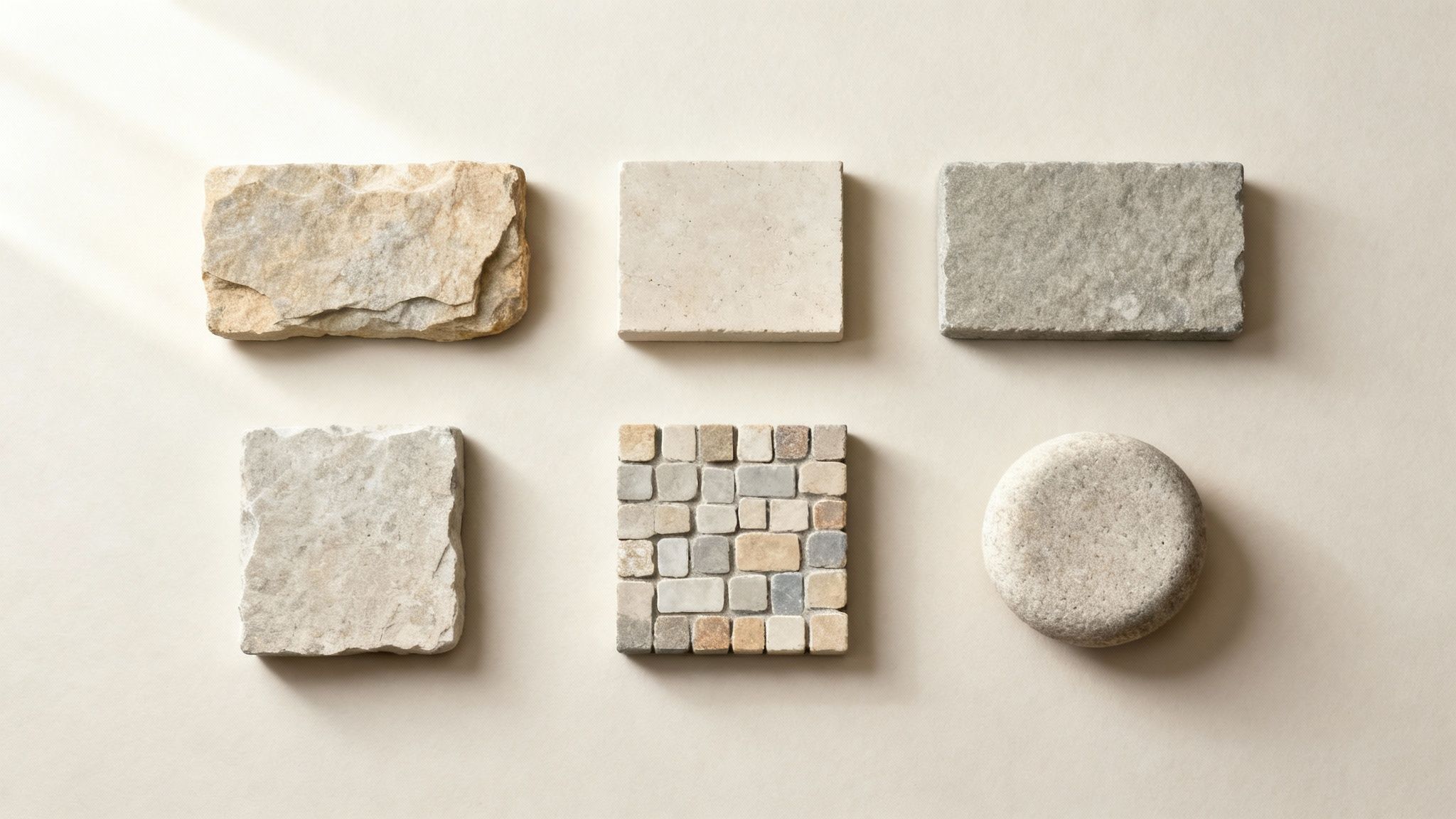
Defining Form with Five Stone Shapes
The shape of the stone creates the pattern and texture of a wall. Each of our five shapes is designed to complement different architectural styles.
- Ledgestone: Thin, linear, rectilinear strips installed with tight horizontal joints for a clean, stacked appearance. Its fine texture is ideal for modern siding and fireplaces.
- Ashlar: Shares the same rectilinear profile as Ledgestone but features taller courses for a larger-scale look. It is often used on building facades and grand entryways.
- Square & Rectangular: A classic shape with blocky, uniform cuts that produce a traditional, orderly pattern. It’s a go-to choice for colonial-style homes and university buildings.
- Mosaic: With irregular, angular pieces, the Mosaic shape resembles an authentic, hand-laid fieldstone wall. It is suited for rustic applications like chimneys and landscape walls.
- Round: Crafted from weathered, cobblestone-style glacial stones common in historic New England. It is ideal for farmhouse foundations and heritage restoration projects.
Capturing Regional Character with Five Color Blends
The color of the stone connects a building to its surroundings. Our five color collections are derived from the unique geology of New England.
- Boston Blend®: Our signature mix of gray, tan, and brown tones. It is adaptable to any style, from coastal to modern.
- Colonial Tan: Features warm gold and brown hues with a strong traditional appeal, pairing well with classic building materials.
- Greenwich Gray: A consistent palette of neutral gray tones that delivers a sophisticated, modern and commercial aesthetic.
- Newport Mist: This blend of soft grays and white tones creates a light, airy, and contemporary feel for modern coastal designs.
- Vineyard Granite: A rugged combination of gray-pink granite with a distinct mica sparkle. This blend offers a bold, textured look for coastal and rustic settings.
Combining these shapes and colors provides complete design control. For example, a Greenwich Gray Ashlar university lobby offers a modern look, while a Colonial Tan Mosaic coastal fireplace provides rustic charm.
By pairing a specific shape with a distinct color blend, you can create a custom exterior that meets your exact design needs. Our system ensures every project gets the authentic character and proven performance of real New England stone, made in the USA.
Explore the full Stoneyard Thin Stone Veneer Collection — real New England stone, made in the USA.
Order free samples at https://stoneyard.com/stone-samples/ or schedule a virtual showroom visit at https://stoneyard.com/contact/.
Getting It Right: Installation and Technical Details
The performance of exterior cladding stone depends on proper installation. Stoneyard’s natural thin stone veneer system is engineered for a straightforward, reliable application. It provides the authentic appearance of full-depth masonry without the heavy lifting or complex footing requirements.
This technical advantage makes it a go-to choice for both new construction and siding retrofits. Each piece of real New England stone is sawn to an approximate thickness of one inch (ranging from ¾–1¼ inches). This reduces the weight to 13-15 pounds per square foot, allowing it to be installed as an adhered veneer.
Prepping the Wall for a Perfect Bond
Installation begins with a properly prepared substrate. Our system is versatile enough for several common wall types.
- For Masonry or Concrete: On unpainted, unsealed concrete block (CMU) or poured concrete walls, our thin veneer can be applied directly using a polymer-modified Type S or Type N mortar.
- For Framed Walls: On wood or steel-framed walls, the process requires a weather-resistant barrier, metal lath, and a cementitious scratch coat. The stone is then set onto this prepared surface.
Because it’s an adhered system, a structural brick ledge is not required, translating to significant savings in time and materials compared to full-bed stone.
How Does Thin Veneer Look So Thick?
The key to achieving a full-depth appearance is in the corners.
For every shape and color collection we offer, we produce matching 90-degree corner pieces. When installed on outside edges, they wrap the corner perfectly, creating the illusion of thick, solid stone blocks. The final result is indistinguishable from traditional masonry.
By combining these specially-cut corners with flat pieces, you get a seamless, continuous look that gives any design genuine substance.
Essential Resources for a Professional Job
A correct installation is non-negotiable for longevity and weather resistance. We provide a full library of technical resources to help builders and masons get it right every time. Our guides walk through every critical step, from wall prep to final grouting.
For a complete overview of best practices—including mortar specs and flashing details—we recommend professionals consult the complete stone veneer installation guide on our website.
Beyond the guides, our team offers project support. We provide material calculators for accurate estimates and connect professionals with contractor-specific resources to ensure your project is a success.
Residential and Commercial Applications
Natural thin stone veneer is a versatile tool for architects and builders. It brings authentic character and proven toughness, making it a go-to choice for creating permanent, low-maintenance exteriors for both residential and commercial projects.
The lightweight nature of a thin stone system allows real stone to be used where traditional, heavy full-bed masonry would not be feasible due to structural limits or budget constraints.
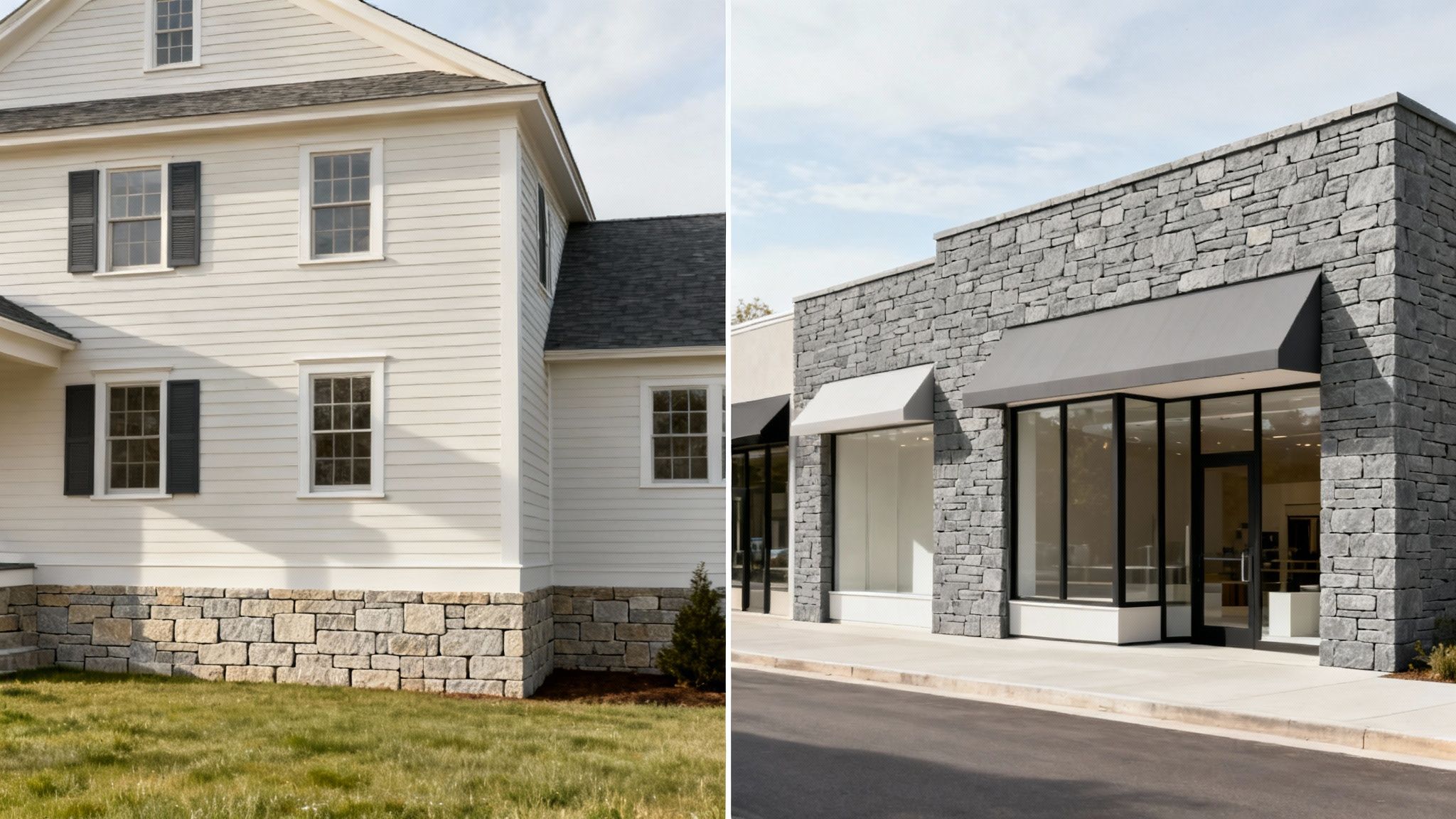
The global demand for high-performance cladding systems is growing, and real stone veneer is a significant part of that trend due to its longevity and timeless appearance.
Common Residential Uses
For homeowners, Stoneyard’s thin stone veneer enhances curb appeal and property value, standing up to even the toughest climates.
- Exterior Siding: Wrapping an entire home in Boston Blend® Ledgestone creates a clean, textured look that protects the structure and makes a strong visual statement.
- Foundations and Water Tables: A foundation in Vineyard Granite Round stone provides a rugged, timeless appearance that looks like it’s been there for generations.
- Chimneys and Accent Walls: A chimney clad in Colonial Tan Mosaic provides an authentic, rustic fieldstone look that serves as an architectural anchor.
- Outdoor Kitchens: Our Harsh Climate Approved (HCA) stone is ideal for building durable outdoor living spaces that withstand freeze-thaw cycles.
Versatility in Commercial Projects
In the commercial world, real stone communicates permanence and quality in a way that concrete lookalikes from brands like Eldorado Stone or Cultured Stone cannot. Businesses use it to define their brand and create building exteriors that are both inviting and durable.
Natural stone cladding communicates authenticity and quality, making a lasting impression on clients, customers, and tenants. Its multi-decade lifespan provides an excellent return on investment for property owners.
You’ll see it used in all kinds of commercial settings:
- Building Facades: A corporate headquarters with a Greenwich Gray Ashlar façade projects a modern, sophisticated image.
- Retail Storefronts: Coastal shops often use Newport Mist Square & Rectangular to create a light, inviting entryway that handles heavy foot traffic.
- University and Civic Buildings: The classic look of Boston Blend® Square & Rectangular is a popular choice for universities blending new buildings with historic campus architecture.
- Hospitality and Restaurants: From country clubs to modern hotels, the unique texture and color of real stone help create a memorable experience for guests.
Presenting high-quality work is crucial for any builder, as shown by firms like Carmel Stone Imports contractor website design. Stoneyard’s product line is here to support any design vision with the unmatched performance of real New England stone.
Got Questions? We’ve Got Answers
Builders and architects often have key questions before specifying a stone product. Here are the technical and practical details about our New England natural thin stone veneer.
Is This Real Stone or a Manufactured Product?
This is 100% real, natural stone, sourced from quarries and fields across New England. Each piece is authentic fieldstone or quarried stone, which we saw to an approximate thickness of one inch at our Littleton, MA facility.
Unlike manufactured concrete products from brands like Eldorado Stone or Cultured Stone, which are concrete poured into molds and painted, our stone has color and texture throughout its body. It will not fade, peel, or delaminate.
How Does Natural Thin Stone Perform in Extreme Weather?
All Stoneyard thin stone veneer is Harsh Climate Approved (HCA). This means the stone has been tested and proven to handle brutal freeze-thaw cycles, driving rain, and salty air common to New England and beyond.
Natural stone has very low water absorption, so it resists the cracking and spalling that plague porous, concrete-based manufactured stone. Its lifespan is measured in decades, with minimal maintenance required.
Can I Achieve a Full-Depth Stone Look?
Yes. We provide matching 90-degree corner pieces for every one of our stone collections. When a mason installs the flat pieces on the wall and wraps the outside edges with these corners, the final look is indistinguishable from traditional, full-bed masonry.
This system provides an authentic, massive stone appearance at approximately one-third the weight. This eliminates the need for heavy-duty structural supports, making it ideal for both new construction and remodels.
What’s the Installation Process for This Stone Cladding?
Natural thin stone veneer is installed over a solid substrate like masonry, concrete blocks (CMU), or a standard wood or steel-framed wall. For framed walls, the process involves a weather-resistant barrier, metal lath, and a cement scratch coat to create a solid base.
Individual stones are then set in a polymer-modified Type S or Type N mortar. The final step is grouting the joints between the stones to lock everything in place. For the full step-by-step process, consult our official Installation Guide.
Explore the full Stoneyard Thin Stone Veneer Collection — real New England stone, made in the USA.
Order free samples at https://stoneyard.com/stone-samples/ or schedule a virtual showroom visit at https://stoneyard.com/contact/.

